Were you aware that the largest T-Rex skeleton ever found was given the name Sue?
Dinosaurs have become some of the most extraordinary creatures to have inhabited this planet.
While it’s enjoyable to envision a time where humans and dinosaurs coexisted, it’s probably not the best idea – we’ve all seen how it turns out in Jurassic Park!
The next best thing is to discover all we can about these prehistoric reptiles and let our imaginations run wild.
We’ve decided to help you out and have researched and compiled the top 100 dinosaur facts that you can imagine.
- Dinosaurs Have Existed for Over 230 Million Years!
- Dinosaurs Lived in the Mesozoic Era.
- They Evolved from Reptiles the Size of House Cats.
- Dinosaurs Are Still Alive and Well Today!
- Pterodactyls Are Not Actually Dinosaurs.
- Dinosaurs Are Divided into Two Main Categories.
- The First Dinosaur was Named Before We Even Knew Dinosaurs Existed.
- The Classification of Dinosaurs
- The Origin of the Name “Dinosaurs”
- The Strange Anatomy of Iguanodons
- Dinosaurs in Literature
- Distinguishing Fossils from Stones
- The Diversity of Dinosaurs
- Dinosaurs Across Continents
- The Titanosaurs
- Carnivores were the smartest dinosaurs.
- The nigersaurus replaced its teeth as often as every fourteen days!
- If a creature lived in water, it wasn’t a dinosaur.
- The micropachycephalosaurus had the longest name of any dinosaur.
- We may never know what caused the extinction of the dinosaurs.
- All herbivorous dinosaurs were four-legged.
- Dinosaurs didn’t all go extinct at the same time.
- In the first Jurassic Park movie, dinosaurs were shown for only 15 minutes.
- A fossil of a protoceratops and a velociraptor in the middle of a deathmatch was found.
- Some dinosaurs may have shed their skin in small chunks, unlike modern snakes and lizards.
- The oviraptor is a funny-looking theropod found in Mongolia that had a beak instead of teeth and likely fed on eggs, hence its name – “egg thief.”
- The brontosaurus was debated for over a hundred years whether it was a unique species or not.
- The therizinosaurs had three scythe-like claws on each arm, making them the longest clawed animal that ever existed.
- All reptiles, including dinosaurs, crocodiles, pterosaurs, mosasaurs, and ichthyosaurs, evolved from the archosaurs between 250 to 200 million years ago.
- Some herbivore dinosaurs intentionally swallowed big stones, known as gastroliths, to grind down the vegetation they ate into digestible pieces.
- Before 1923, there was no proof that dinosaurs laid eggs.
- Dinosaurs had different types of eggs.
- Some ichthyosaurs gave birth tail-first.
- The largest carnivorous dinosaur was the Spinosaurus.
- The color of dinosaurs is unknown.
- The Quetzalcoatlus northropi had the largest wingspan of any known pterosaur.
- The Qantassaurus was named after an Australian airline.
- Dinosaur speed can be estimated from fossilized footprints.
- Mary Anning was an unrecognized pioneer in paleontology.
- Some dinosaurs had ostrich-like limbs and were very fast.
- The kosmoceratops had an elaborate skull with fifteen horns.
- The raptors in Jurassic Park were actually based on a different species.
- Deinonychuses probably used their sharp claws to disembowel prey.
- Velociraptors were similar in size to turkeys.
- Velociraptors were given their name for their speed and thievery.
- The pentaceratops had the largest skull of any known dinosaur.
- Many dinosaurs in Jurassic Park did not exist during the Jurassic period.
- Pachycephalosaurus wyomingensis had an exceptionally thick skull.
- Brachiosauruses had long necks like giraffes.
- The T-Rex was dubbed the “Tyrant King.”
- The largest T-Rex skeleton ever found was named Sue.
- Over fifty T-Rex skeletons have been discovered.
- A T-Rex had the strongest bite force of any land animal.
- The stegosaurus is Colorado’s official state dinosaur.
- Nicolas Cage once spent $276,000 on a rare dinosaur skull.
- The Ankylosaurus had a massive club-like tail to defend itself.
- The smallest dinosaur egg in the world is smaller than a golf ball.
- Triceratops were able to defend against tyrannosauruses with their huge horns.
- Dilophosauruses did not spit poison.
- The smallest pterodactyl was the size of a pigeon.
- Opalized dinosaur fossils have been found in Australia.
- Fred Flintstone’s pet dinosaur Dino was a fictional snorkasaurus.
- If Godzilla were a real dinosaur, it would have been a type of theropod.
- The time span between T-rexes and stegosauruses is greater than the gap between humans and T-rexes.
- Some dinosaurs were enormous, but none were larger than blue whales.
- The Size Comparison of Blue Whales and Dinosaurs
- FAQ
Dinosaurs Have Existed for Over 230 Million Years!
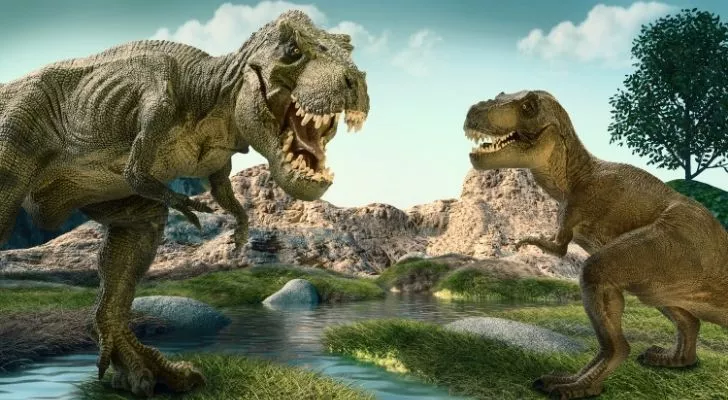
Roughly 250 million years ago, most life on Earth went extinct, and within the following ten million years or so, dinosaurs began to evolve.
The exact time when dinosaurs first appeared is uncertain, but we know for sure that it was between 230-245 million years ago.
Dinosaurs Lived in the Mesozoic Era.
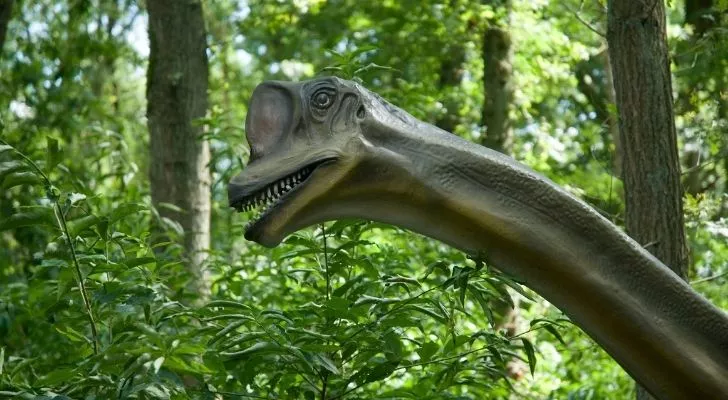
The Mesozoic era lasted from approximately 245 to 66 million years ago and is typically divided into three periods: the Triassic, Jurassic, and Cretaceous periods.
Dinosaurs initially evolved during the Triassic period, increased in number and diversity in the Jurassic period, further evolved during the Cretaceous period, and then, well, pretty much just went extinct.
They Evolved from Reptiles the Size of House Cats.
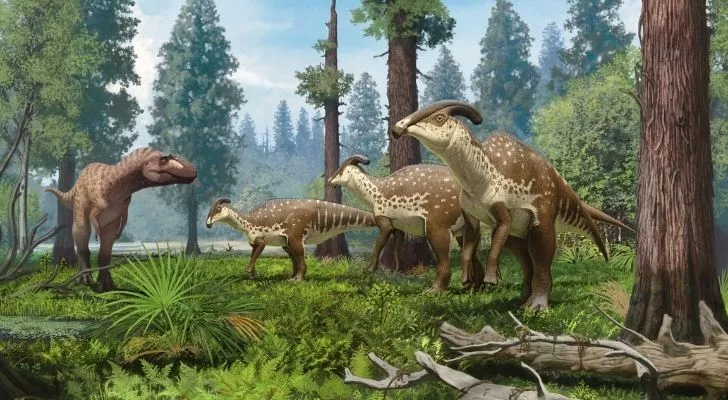
Between approximately 244 to 242 million years ago, small but nimble reptiles known as dinosauromorphs rapidly expanded and spread across the globe.
Although they were far too tiny to come anywhere near the top of the food chain, they were quick enough to evade predators long enough to evolve into dinosaurs!
Dinosaurs Are Still Alive and Well Today!

Don’t panic, though, unless you’re terribly afraid of chickens!
In reality, all birds are descendants of dinosaurs – even the smallest hummingbird.
All non-avian dinosaurs went extinct, but avian dinosaurs evolved over the centuries into birds.
Pterodactyls Are Not Actually Dinosaurs.

Pterodactyls, along with all other winged dinosaur-like reptiles, do not belong to the dinosaur family but are classified as Pterosaurs.
While Pterosaurs are indeed related to dinosaurs, the connection is quite distant, splitting off from the archosaurs.
Dinosaurs Are Divided into Two Main Categories.
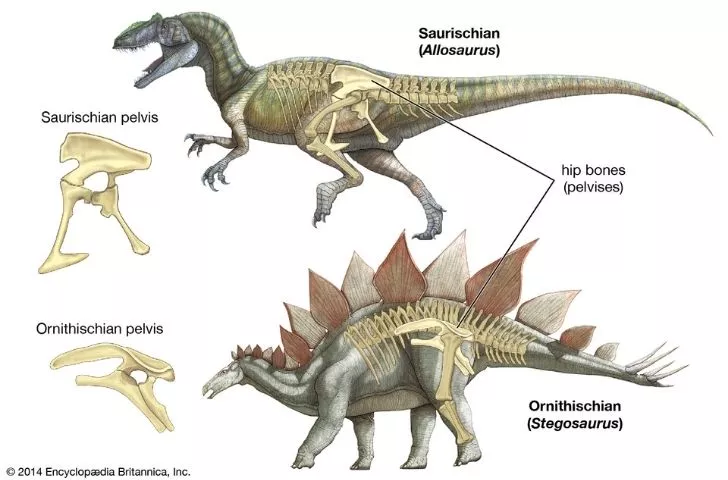
In simple terms, a dinosaur is either a saurischian (Greek for “lizard-hipped”) or an ornithischian (Greek for “bird-hipped”).
Interestingly, the lizard-hipped dinosaurs are more commonly related to modern-day birds, while the bird-hipped dinosaurs all went extinct!
The First Dinosaur was Named Before We Even Knew Dinosaurs Existed.

In 1815, William Buckland, a geology professor from Oxford University, stumbled upon the skeleton of an animal unlike any previously known.
Deciding that it was some form of long-extinct reptile, he named it “Megalosaurus” (Greek for “great lizard”).
The Classification of Dinosaurs
In 1842, Sir Richard Owen, a geologist who later founded London’s Natural History Museum, classified the fossils of giant reptiles discovered in England as belonging to the “Dinosauria” family, which means “terrible lizards” in Greek. This was only seven years after the discovery of the megalosaurus by William Buckland.
The Origin of the Name “Dinosaurs”
Contrary to popular belief, the word “terrible” in “terrible lizards” did not refer to the terror that dinosaurs inspired. Sir Richard Owen used the word to describe the “fearfully great” size of dinosaurs which exceeded that of any other reptiles known at the time.
The Strange Anatomy of Iguanodons
Iguanodons were among the first dinosaurs to be discovered. However, it wasn’t until 40 years after the first skeleton was reconstructed that scientists realized the strange spiky digit on the dinosaur’s front limb was actually a thumb. Paleontologists are still unsure of the purpose of this unique appendage.
Dinosaurs in Literature
Charles Dickens, one of the most famous British authors of the 19th century, included the megalosaurus in his novel Bleak House. Despite the size and ferocity of the megalosaurus, Dickens described it as an “elephantine lizard.”
Distinguishing Fossils from Stones
One way to distinguish a fossil from a stone is to lick it. Fossils are more porous than stones and will stick slightly to your tongue. This is a common practice among paleontologists.
The Diversity of Dinosaurs
More than 900 species of non-avian dinosaurs have been identified by scientists. These are species with enough fossil evidence to be deemed valid. However, there are many more potential species that lack solid evidence.
Dinosaurs Across Continents
Dinosaurs lived on all of Earth’s continents. When dinosaurs first appeared in the Triassic period, the continents were clustered together in a giant supercontinent called Pangaea. Over the following 165 million years, as dinosaurs roamed the earth, Pangaea slowly drifted apart, separating many dinosaur species from each other.
The Titanosaurs
Titanosaurs were the largest dinosaurs that ever lived. These massive creatures roamed the earth millions of years ago and were among the last dinosaurs to go extinct.
The titanosaurs were a type of sauropods, which were plant-eating quadrupeds with long necks and small heads. They lived towards the end of the dinosaur era, from about 145-66 million years ago. It is still unclear which of them was the largest due to the lack of well-preserved fossils, but the argentinosaurus is believed to be the biggest, weighing in at 99 to 110 tons (90 to 100 tonnes)!
On the other hand, the europasaurus was a unique sauropod. While it looked like its relatives, it never grew to be as massive as them. Its length of 19’ 8” (6 meters) was still quite impressive but nowhere near the size of its football field-sized cousins.
The gallimimus is a strange-looking theropod that once roamed Mongolia during the late Cretaceous period. Despite its name “chicken mimic,” it resembled a giant ostrich with arms.
Fossils of dinosaurs are found in several places worldwide, but the high-altitude badlands of China, Argentina, and North America contain some of the largest accessible amounts of fossils.
Did you know that some pterosaurs were covered in fur? These creatures would look similar to fruit bats, but on a much larger scale.
Most dinosaur fossils aren’t actual bones anymore. The fossilization process typically occurs when organic material gets trapped in layers of sediment or sand and then surrounded by water. The original material is then replaced by various minerals, creating a rock-like copy.
Until the 1990s, it was believed that all dinosaurs had large scales like modern reptiles. However, more recent evidence proves that theropods, including velociraptors, tyrannosaurus rexes, and birds’ ancestors, had feathers.
Despite their fearsome reputation, dinosaurs were not very intelligent creatures, with brains the size of a lime in bodies up to 29 feet and 6 inches (9 meters) long.
Finally, during the late 19th century, two famous paleontologists, Othniel Charles Marsh and Edward Drinker Cope, tried to spark interest in paleontology in North America. Although they started as friends, they became rivals in a lifelong competition to prove their scientific superiority.
Even though both men ended up degrading themselves and could be considered losers, they essentially gave birth to the entire paleontology scene in the United States.
Carnivores were the smartest dinosaurs.

Specifically, the theropods, who were predators, were the ones to watch out for during prehistoric times.
At the lower end of this group, the infamous t-rex had a significantly larger brain than the herbivorous stegosaurus.
The smartest of all were the small, agile theropods like the velociraptor or the troodontids, which had brains similar to those of flightless birds today.
The nigersaurus replaced its teeth as often as every fourteen days!
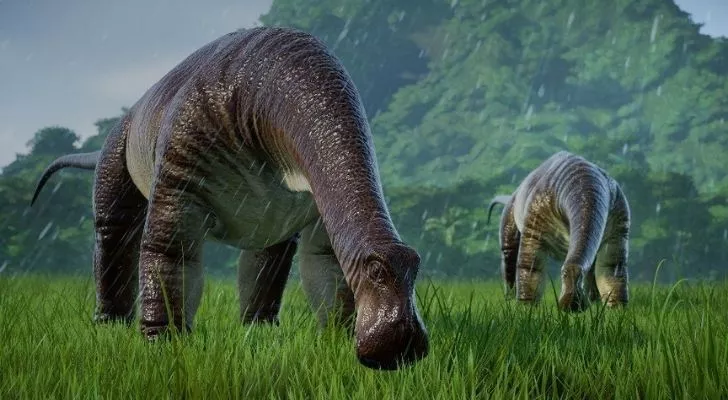
This remarkable sauropod had rows and rows of teeth in reserve, hidden away in its mouth.
When a set of teeth wore out, they would fall out, and the next row would move into position.
If a creature lived in water, it wasn’t a dinosaur.

Some of the first fossils of ancient reptiles found were great beastly creatures that, by all appearances, predominately lived underwater and were promptly classified as plesiosaurs.
While they also share a common ancestor with dinosaurs, they’re so distantly related that they remain in their own group.
The micropachycephalosaurus had the longest name of any dinosaur.

Try saying that all in one go without stopping!
With 23 letters and nine syllables, the micropachycephalosaurus has an incredibly difficult and long name for such a small dinosaur.
After all, its name translates to “small thick-headed lizard.”
We may never know what caused the extinction of the dinosaurs.

The Cretaceous extinction was one of the largest mass extinctions the world has ever seen, but as it happened some 66 million years ago, we may never be able to determine how it happened.
Around this time, an asteroid crashed into Earth just off the coast of Mexico, which is largely to blame for the death of all non-avian dinosaurs.
While it’s a good theory, there are also many other ideas for how the dinosaurs died out – with climate change being the other most likely culprit!
All herbivorous dinosaurs were four-legged.

That’s not to say that all herbivorous dinosaurs were four-legged, though.
While that is a common misconception, it turns out that there were quite a few herbivorous dinosaurs that could walk on two legs, at least for short periods of time!
Dinosaurs didn’t all go extinct at the same time.
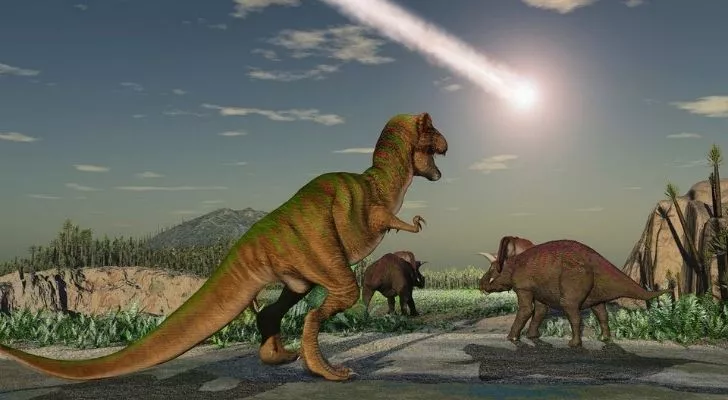
The asteroid which crashed into Earth didn’t wipe out all the dinosaurs at once.
Instead, it likely triggered a chain reaction of events that completely changed the face of the planet.
This, of course, didn’t happen overnight, but over the following few hundred or even thousands of years, slowly killing off all but the avian dinosaurs.
In the first Jurassic Park movie, dinosaurs were shown for only 15 minutes.
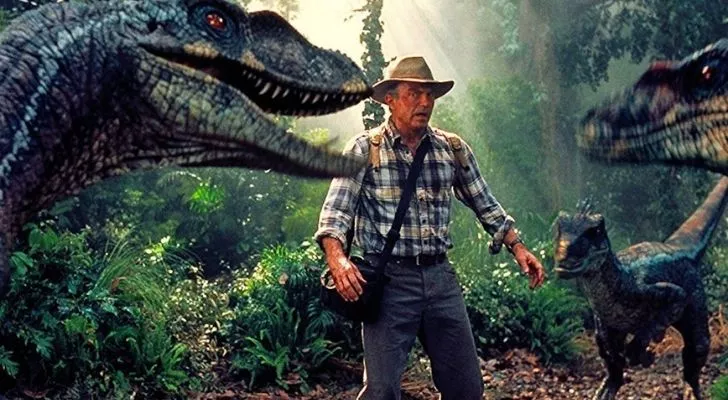
Nine minutes of those were taken up by animatronic dinosaurs, such as the large robotic T-Rex.
In 1993, one of the ten dinosaurs in the movie Jurassic Park was not created by CGI. The Microraptor, a small bird-like dinosaur, had four wings – two on its front legs and two on its rear legs. The Corythosaurus used its hollow crest to make low-frequency sounds. Most dinosaurs were herbivores and were hunted by carnivorous dinosaurs that lived at the top of the food chain. The Regaliceratops peterhewsi, a new triceratops relative, was nicknamed “Hellboy” due to its unique skull shape. Some carnivorous dinosaurs had hollow bones, which made them lighter and improved their breathing abilities. King Edward VII requested a cast of the first diplodocus skeleton for London’s Natural History Museum after seeing sketches of it in 1902. Diplodocuses had the longest tails of any known dinosaurs, measuring 46 feet long. The plates along the backs of Stegosauruses were not used for defense, but were either used for display or to regulate their temperature. The average weight of all known dinosaurs was approximately 7,700 pounds.
So, what was the average size of a dinosaur? Somewhere between an elephant and a rhino.
A fossil of a protoceratops and a velociraptor in the middle of a deathmatch was found.
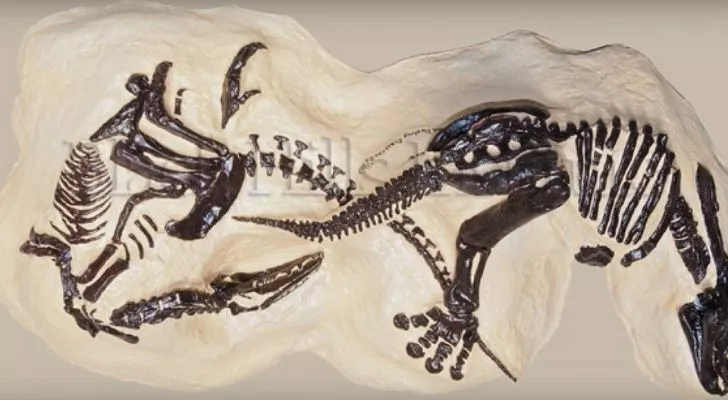
The two were stuck in a landslide, preserving them for millions of years. The velociraptor had its claws dug into the protoceratops’ neck, but the protoceratops had its jaws on the velociraptor’s arm, breaking it.
Some dinosaurs may have shed their skin in small chunks, unlike modern snakes and lizards.

Bird-like dinosaurs are the only evidence we have of this.
The oviraptor is a funny-looking theropod found in Mongolia that had a beak instead of teeth and likely fed on eggs, hence its name – “egg thief.”
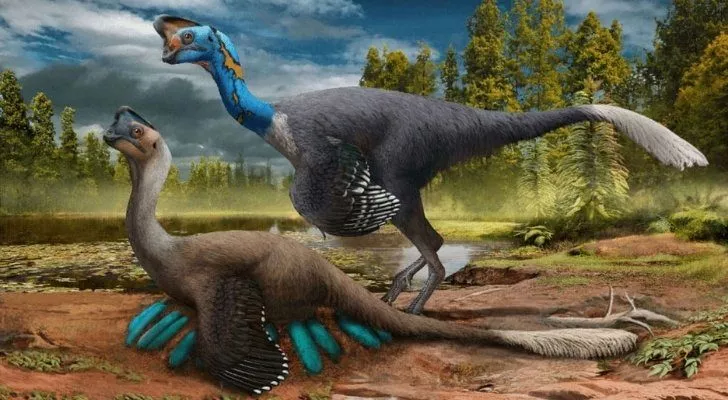
They lived about 85-75 million years ago.
The brontosaurus was debated for over a hundred years whether it was a unique species or not.
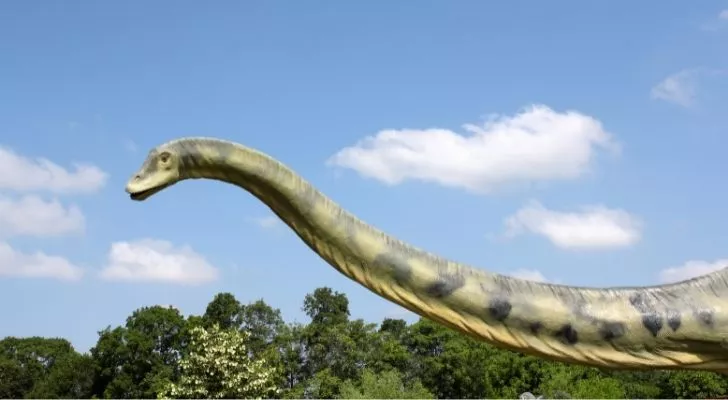
All brontosaurus skeletons were labeled as apatosauruses until a study in 2015 confirmed that they were their own species.
The therizinosaurs had three scythe-like claws on each arm, making them the longest clawed animal that ever existed.
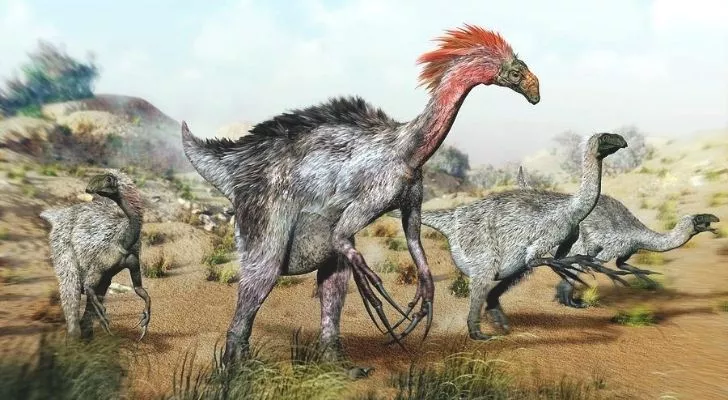
They were also called the “reaping lizard”.
All reptiles, including dinosaurs, crocodiles, pterosaurs, mosasaurs, and ichthyosaurs, evolved from the archosaurs between 250 to 200 million years ago.
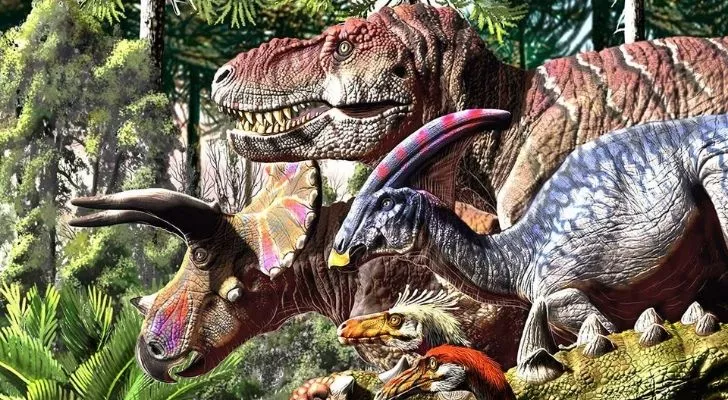
The archosaurs were their common ancestors.
Some herbivore dinosaurs intentionally swallowed big stones, known as gastroliths, to grind down the vegetation they ate into digestible pieces.

Plesiosaurs also swallowed stones to manage their buoyancy.
Before 1923, there was no proof that dinosaurs laid eggs.
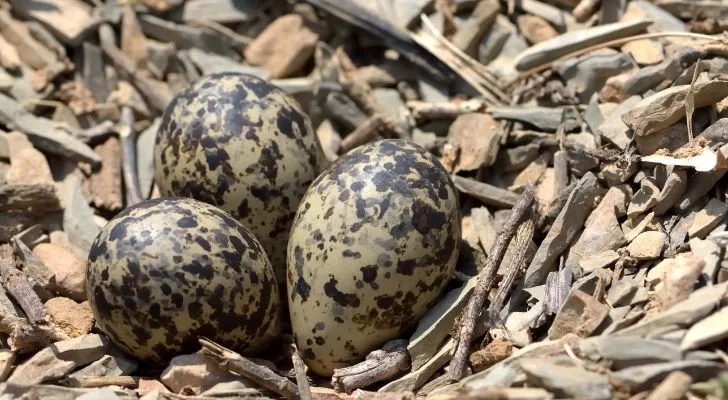
A collection of fossilized dinosaur eggs discovered in Mongolia in 1923 confirmed this suspicion.
Dinosaurs had different types of eggs.
Most of the fossilized dinosaur eggs discovered had hard shells, similar to modern-day bird eggs. However, some of the earliest dinosaurs laid soft-shelled eggs and buried them like lizards.
Some ichthyosaurs gave birth tail-first.
Ichthyosaurs like the Stenopterygius were reptiles similar to dolphins. Instead of laying eggs, they developed their young in embryos and gave birth to them when they were ready to swim. Some ichthyosaurs gave birth tail-first to prevent drowning before reaching the water surface.
The largest carnivorous dinosaur was the Spinosaurus.
The Spinosaurus was not only the biggest meat-eating dinosaur, but also had huge spines on its back forming a sail. The largest fossil found indicates they could grow up to 18m long and weigh up to 23 tons.
The color of dinosaurs is unknown.
It is theorized that dinosaurs might have had dull colors to blend in with their environment and avoid predators. On the other hand, some scientists suggest they were brightly colored to attract potential mates.
The Quetzalcoatlus northropi had the largest wingspan of any known pterosaur.
The Quetzalcoatlus northropi lived in the late Cretaceous period and had a wingspan of 23-43 feet. It was named after the Mesoamerican god.
The Qantassaurus was named after an Australian airline.
The Qantassaurus is a six-foot-long herbivore discovered in Victoria, Australia. It was named after QANTAS, the airline that sponsored the transport of many dinosaur fossils across Australia.
Dinosaur speed can be estimated from fossilized footprints.
It is difficult to identify which footprint belongs to which dinosaur, but from the analysis of fossilized footprints, it was discovered that some dinosaurs were as fast as 25 miles per hour.
Mary Anning was an unrecognized pioneer in paleontology.
At the beginning of the 19th century, science was dominated by men, making it difficult for Mary Anning to gain recognition for her work. She discovered many fossils, including the first-ever pterosaur found outside of Germany.
Some dinosaurs had ostrich-like limbs and were very fast.
The ostrich mimic ornithomimids were among the fastest dinosaurs, reaching speeds up to 25 miles per hour. They were bird-like and covered in feathers.
The kosmoceratops had an elaborate skull with fifteen horns.
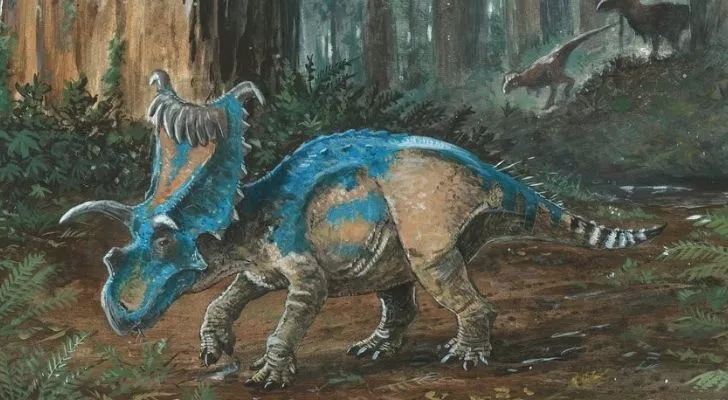
The kosmoceratops, a relative of the triceratops, had more horns than any other known dinosaur, making its skull the most ornate.
It lived during the late Cretaceous period, which occurred between 76-75 million years ago.
The raptors in Jurassic Park were actually based on a different species.

The raptors in the novel and films were modeled after deinonychuses, a larger and distinct species found in the US.
Michael Crichton, the author of Jurassic Park, consulted with the discoverer of the deinonychus to learn about its behavior.
He even acknowledged that the raptors in his novel were essentially deinonychuses.
Deinonychuses probably used their sharp claws to disembowel prey.
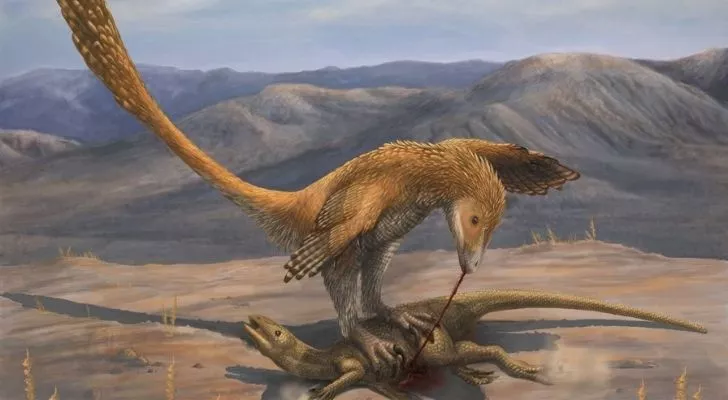
Their oversized hind claw was so sharp that they were named “terrible claw.”
This claw allowed them to inflict fatal wounds on their prey before waiting at a safe distance until they perished.
Velociraptors were similar in size to turkeys.
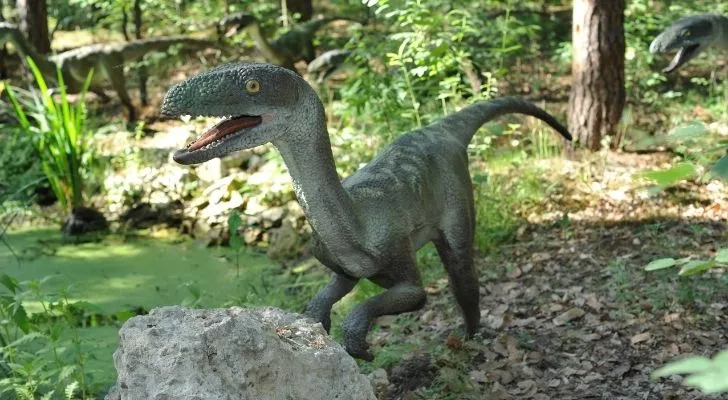
Despite being intimidating, they were not as terrifying as the raptors depicted in Jurassic Park.
Newly discovered fossils revealed that velociraptors had long, feathered tails and wings on their arms.
Velociraptors were given their name for their speed and thievery.
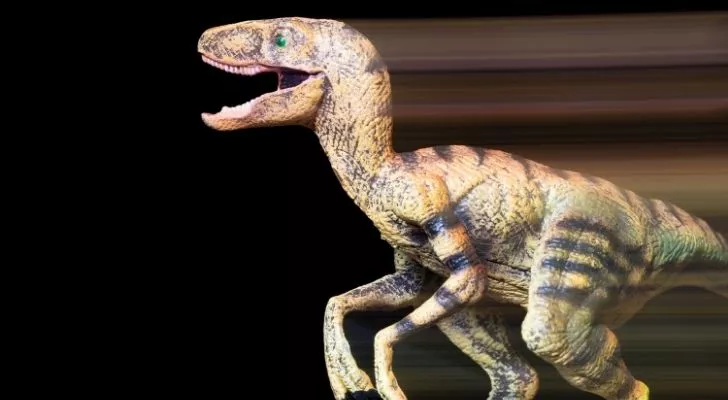
Henry Fairfield Osborn, president of the American Museum of Natural History in 1924, named the velociraptor due to its swift and agile predatory nature.
The pentaceratops had the largest skull of any known dinosaur.

Measuring at 10.49 feet (3.2 m) high, the skull of the pentaceratops was also the largest of any animal to have lived on Earth.
Many dinosaurs in Jurassic Park did not exist during the Jurassic period.
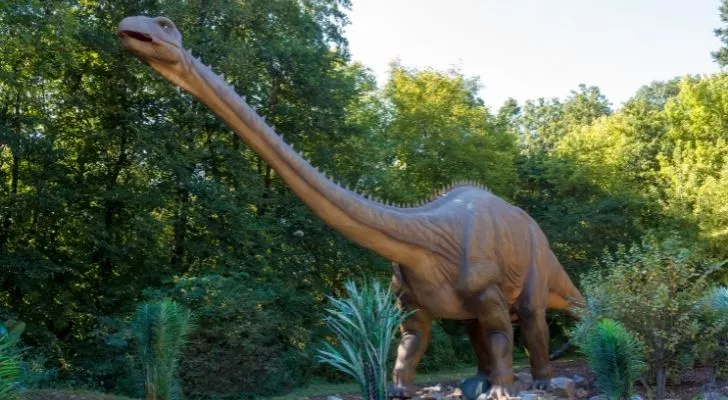
While the Jurassic Park series popularized dinosaurs, it was not entirely accurate.
Only the brachiosaurus and dilophosaurus in the first film belonged to the Jurassic period, while the others were mostly from the Cretaceous period.
The Jurassic period occurred between 200 to 145 million years ago, while the Cretaceous period occurred from 145 to 66 million years ago.
Pachycephalosaurus wyomingensis had an exceptionally thick skull.
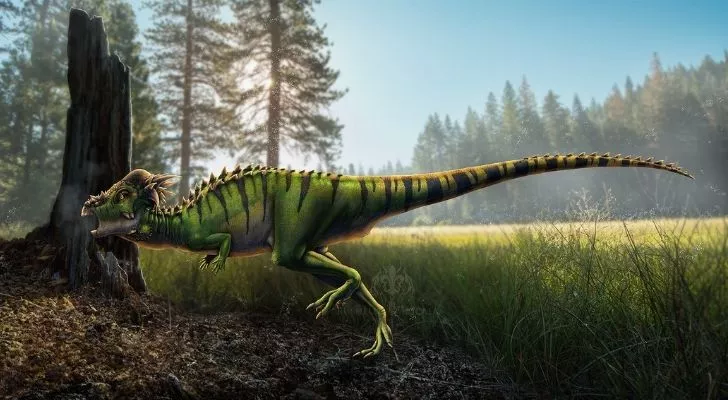
This thick-skulled dinosaur likely had the thickest skull of all, leading paleontologists to speculate its purpose.
Some believe they used their heads to butt each other to display strength, but this theory is uncertain as their necks may not have been strong enough to withstand such impacts.
Brachiosauruses had long necks like giraffes.

As herbivores, brachiosauruses used their long necks to reach the highest parts of trees, which were untouched by smaller dinosaurs.
The dinosaur known as the “arms lizard” had longer front legs than back legs. Fossilized dinosaur feces, or coprolite, is highly valued by collectors, with the largest collection owned by George Frandsen. Frandsen’s interest in coprolite began during his studies in paleontology, as it provides insight into a dinosaur’s lifestyle and diet. The largest piece of carnivore coprolite, nicknamed “Barnum,” weighs 20.47 lbs and is owned by Frandsen. Despite popular belief, Nintendo has officially stated that Yoshi is not a dinosaur. The first complete dinosaur skeleton to be mounted in a museum was a hadrosaurus. The hadrosaurs, including the Edmontosaurus and Parasaurolophus, had the most teeth with up to 960 flat teeth for grinding plant matter. The deinocheirus was known for its arms for 50 years until full skeletons were discovered, revealing an awkward-looking dinosaur. Hogwarts School of Witchcraft and Wizardry has a dinosaur named after it, Dracorex hogwartsia, due to its skull resembling a mythical dragon. A feathered dinosaur tail was found preserved in amber from Myanmar.
The T-Rex was dubbed the “Tyrant King.”

The name literally translates to this title. These vicious creatures were among the largest predatory dinosaurs, hence the name!
Despite being featured in the movie Jurassic Park, they existed during the Cretaceous period.
The largest T-Rex skeleton ever found was named Sue.

Although not the most frightening name, Sue the Tyrant King has a nice ring to it. The skeleton was discovered by Sue Hendrickson and later named in her honor. It was a huge creature, measuring 13 feet (4 m) tall at the hips and 40 feet (12.3 m) long.
Over fifty T-Rex skeletons have been discovered.
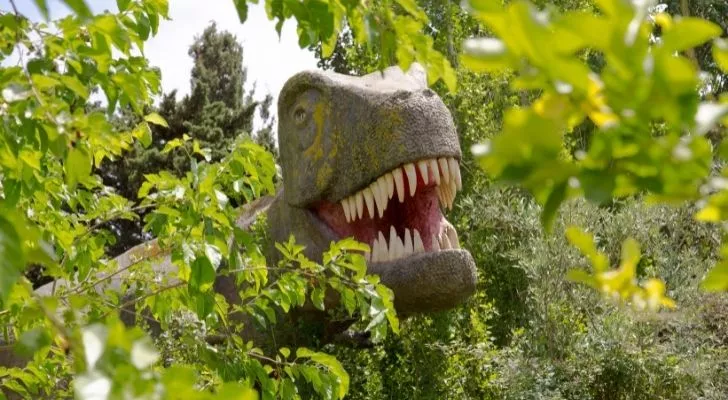
Tyrannosaurus rexes have been found all across western North America, making them one of the more mobile dinosaurs of their time. While many of the fossils were fragmented, a few of them were almost complete, allowing for great reconstructions.
A T-Rex had the strongest bite force of any land animal.
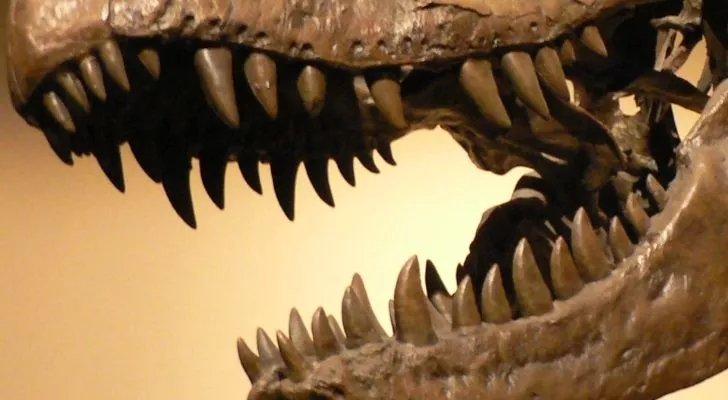
Recent calculations indicate that they could bite down with a force of 7.1 tons (6.5 tonnes), about four times that of a saltwater crocodile. This force enabled them to bite straight through bones, including those of giant dinosaurs!
The stegosaurus is Colorado’s official state dinosaur.
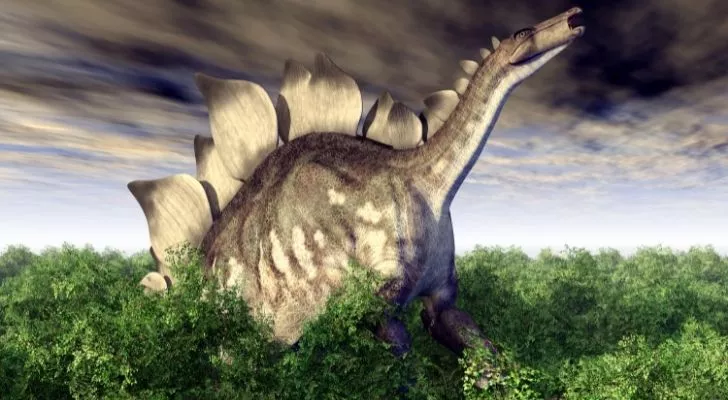
The first stegosaurus fossil was discovered just outside Denver, Colorado, in 1876. It was named the “covered lizard” because of its protective scales. However, it was only designated as Colorado’s state dinosaur in 1982.
Nicolas Cage once spent $276,000 on a rare dinosaur skull.
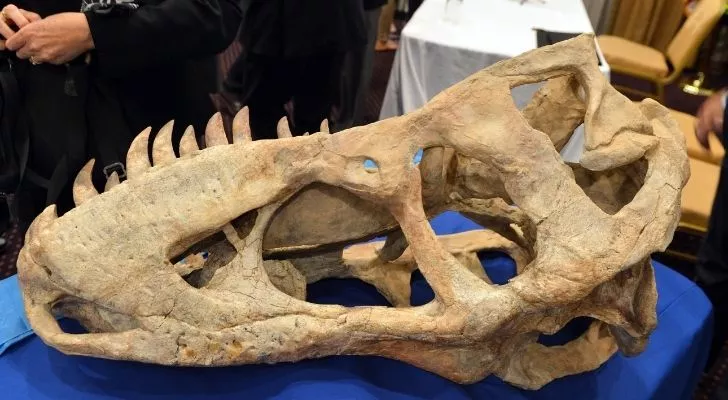
In 2007, Cage outbid Leonardo Di Caprio for the skull of a Tyrannosaurus bataar, a close relative of the T-Rex. However, in 2014, it was discovered that the skull had been stolen from Mongolia. Cage returned the rare skull to the Mongolian government.
The Ankylosaurus had a massive club-like tail to defend itself.

While many herbivores were easy prey for predators like the T-Rex, the Ankylosaurus had the perfect defense. It had a large bony club at the end of its tail and spike-studded bony plates all over its body. Its only vulnerable spot was its soft underbelly, making it difficult for predators to attack.
The smallest dinosaur egg in the world is smaller than a golf ball.

The egg was only 1.75 inches (45 mm) by 0.78 inches (20 mm) and weighed just 0.35 ounces (10 g), about the same size and weight as a quail egg.
One of the theropods, carnivorous dinosaurs that walked on two legs, is believed to have laid an egg 110 million years ago. However, the world’s largest dinosaur eggs ever discovered were oviraptorosaur eggs that were found in China in the 1990s. These eggs measured approximately 1.6 feet in length. Previously, they were assumed to be Tyrannosaur eggs, but it was later discovered that they were from a giant oviraptorosaur species. The tallest dinosaur, sauroposeidon, whose name means “lizard earthquake god,” could reach up to 59 feet in height. Stegosauruses and allosauruses were known to fight to the death, with the latter being impaled by the former’s tail spike. Many dinosaurs traveled in herds, which offered greater protection for herbivorous dinosaurs and more successful hunting for predators. In the movie Jurassic Park, the T-Rex’s roar was created by combining the sounds of a baby elephant’s squeal, an alligator’s gurgling, and an angry tiger’s snarl. It is likely that dinosaurs were not cold-blooded, but rather found a middle ground between cold-blooded and warm-blooded. T-Rexes probably lived for a little over thirty years, while large sauropods had the longest lifespan out of all dinosaurs, living up to 70-80 years. Finally, it is believed that sauropods ate over 1 ton of plant matter each day, while the largest plesiosaur was approximately 46 feet long.
Imagine taking a sauropod, replacing its legs with flippers, shortening its tail, and giving it sharp teeth before throwing it into the ocean. You would end up with a plesiosaurus, specifically the Elasmosaurus platyurus. This was the heaviest and longest plesiosaur, weighing around 24 tons (22 tonnes).
Triceratops were able to defend against tyrannosauruses with their huge horns.
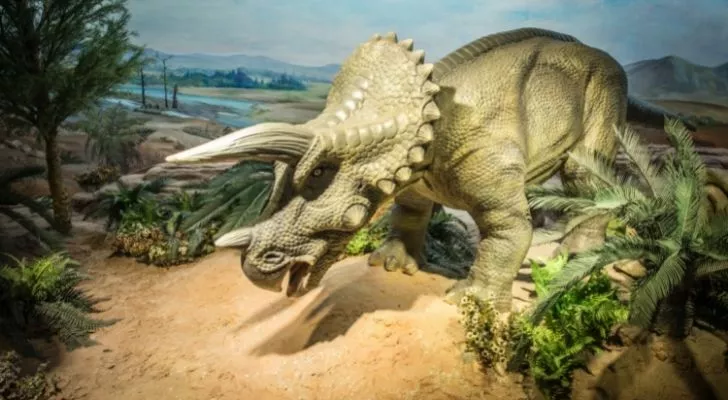
The name Triceratops translates to “three-horned face” which is a bit uninspired. While their horns were likely used for attracting mates, they were also useful for self-defense. One skeleton was found with a broken horn and bite marks from a tyrannosaurus.
Dilophosauruses did not spit poison.
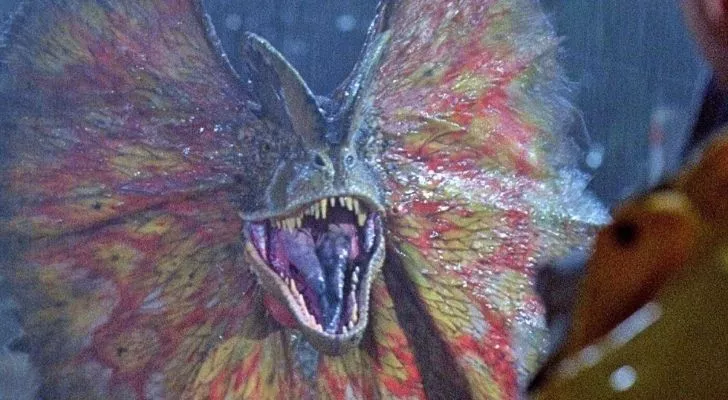
Jurassic Park got a lot of things wrong about this dinosaur. It did not spit poison, have a large frill like a frill-necked lizard, or even resemble the small creature depicted in the film. However, this double-crested dinosaur was still pretty impressive-looking!
The smallest pterodactyl was the size of a pigeon.

Nemicolopterus crypticus, discovered in northeastern China, would have flown from tree to tree in search of insects around 120 million years ago. With a wingspan of just 10 inches (25 cm), it is hard to imagine it being related to the massive quetzalcoatlus!
Opalized dinosaur fossils have been found in Australia.
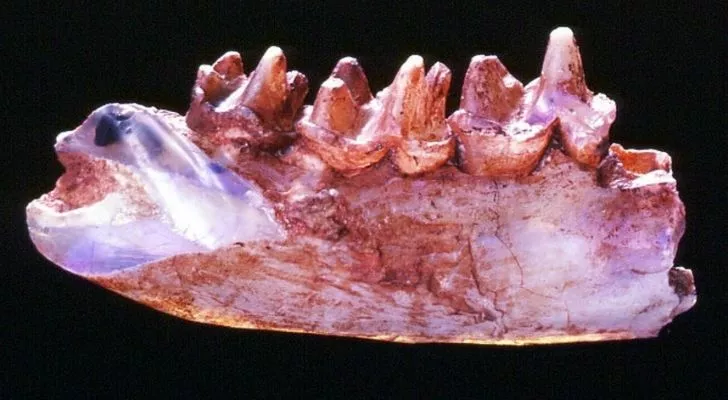
One of the most famous sets of opalized dinosaur fossils discovered was a pair of dinosaur jawbone fragments with teeth that had a unique vein of opal running through the bone. These pieces were later identified in 2017 as belonging to a new species of dinosaur called Weewarrasaurus pobeni.
Fred Flintstone’s pet dinosaur Dino was a fictional snorkasaurus.

Unfortunately, a snorkasaurus is not a real dinosaur. However, Dino was likely inspired by sauropods, although significantly smaller in size.
If Godzilla were a real dinosaur, it would have been a type of theropod.
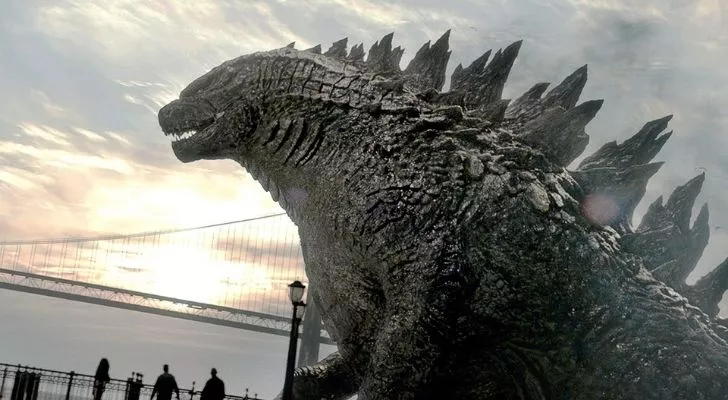
In 1998, a paleontologist attempted to identify what type of dinosaur Godzilla might have been based on its anatomy. It was ultimately decided that the 90s version of Godzilla would have been related to a group of theropods called ceratosaurs.
The time span between T-rexes and stegosauruses is greater than the gap between humans and T-rexes.
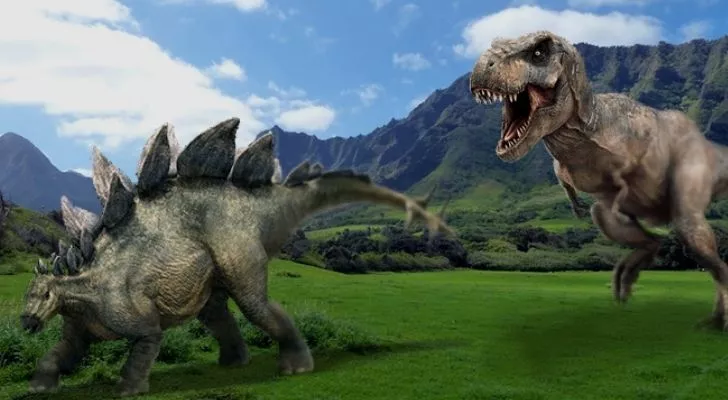
Stegosauruses existed during the late Jurassic period, about 150 million years ago, while T-Rexes lived during the Cretaceous period, about 65 million years ago. This puts the duration of the dinosaurs’ existence into perspective!
Some dinosaurs were enormous, but none were larger than blue whales.
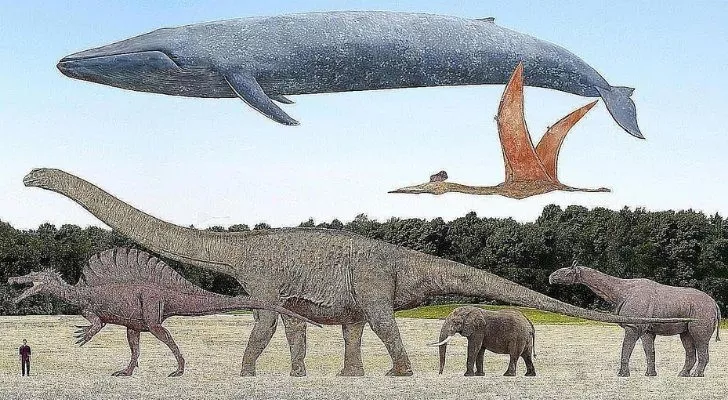
The Size Comparison of Blue Whales and Dinosaurs
Blue whales, which can weigh up to 190 tons (172.4 tonnes) and grow 110 feet (34 m) long, are the largest animals on Earth. In contrast, the heaviest dinosaurs weighed up to 69 tons (62.6 tonnes) and measured up to 120 feet (36.5 m) long.
One reason for the difference in size is that the weight of whales is supported by water, whereas dinosaurs had to support their weight with their legs. This made it easier for whales to grow much heavier than dinosaurs.
Despite our knowledge of dinosaurs, there is still much that we don’t know about them, which makes them even more intriguing. However, we have been discovering more dinosaurs than ever before, which is a thrilling prospect for paleontologists.
While it’s unlikely that we will ever find dino DNA and reconstruct them, there is still a lot to learn about these fascinating creatures.
FAQ
1. What is the largest dinosaur ever discovered?
The largest dinosaur ever discovered is the Argentinosaurus, which weighed an estimated 100 tons and measured up to 100 feet long. This massive herbivore lived during the Late Cretaceous period in what is now Argentina.
2. What is the smallest dinosaur ever discovered?
The smallest dinosaur ever discovered is the Microraptor, which was about the size of a crow. This feathered dinosaur lived during the Early Cretaceous period in what is now China.
3. Did all dinosaurs lay eggs?
Yes, all dinosaurs laid eggs. In fact, some dinosaur eggs have been preserved and studied by scientists, providing valuable insights into dinosaur reproduction.
4. How did dinosaurs become extinct?
There is still some debate among scientists about how dinosaurs became extinct, but the most widely accepted theory is that a massive asteroid impact caused a chain reaction of events that led to their demise. This impact caused widespread destruction, including massive fires, earthquakes, and a cloud of dust that blocked out the sun, leading to a global cooling effect and a drastic change in climate.
5. Were all dinosaurs carnivorous?
No, not all dinosaurs were carnivorous. In fact, many dinosaurs were herbivores, such as the Triceratops and the Stegosaurus. Other dinosaurs were omnivores, meaning they ate both plants and animals.
6. How many different types of dinosaurs have been discovered?
Scientists have identified and named over 1,000 different species of dinosaurs. However, they believe that there were many more species that have yet to be discovered.
7. Did dinosaurs have feathers?
Yes, many dinosaurs had feathers, including some of the largest and most well-known species, such as the Tyrannosaurus Rex and the Velociraptor. Scientists believe that the evolution of feathers in dinosaurs may have been related to insulation, display, and even flight.
8. Where can I see dinosaur fossils?
Dinosaur fossils can be found in museums all over the world. Some of the most well-known museums for dinosaur exhibits include the American Museum of Natural History in New York City, the Royal Tyrrell Museum in Alberta, Canada, and the Natural History Museum in London, England.

Zayn Anderson is a prolific writer with a passion for uncovering the world’s intriguing facts. Armed with an insatiable curiosity, he delves into various subjects, from history and science to nature and technology.
